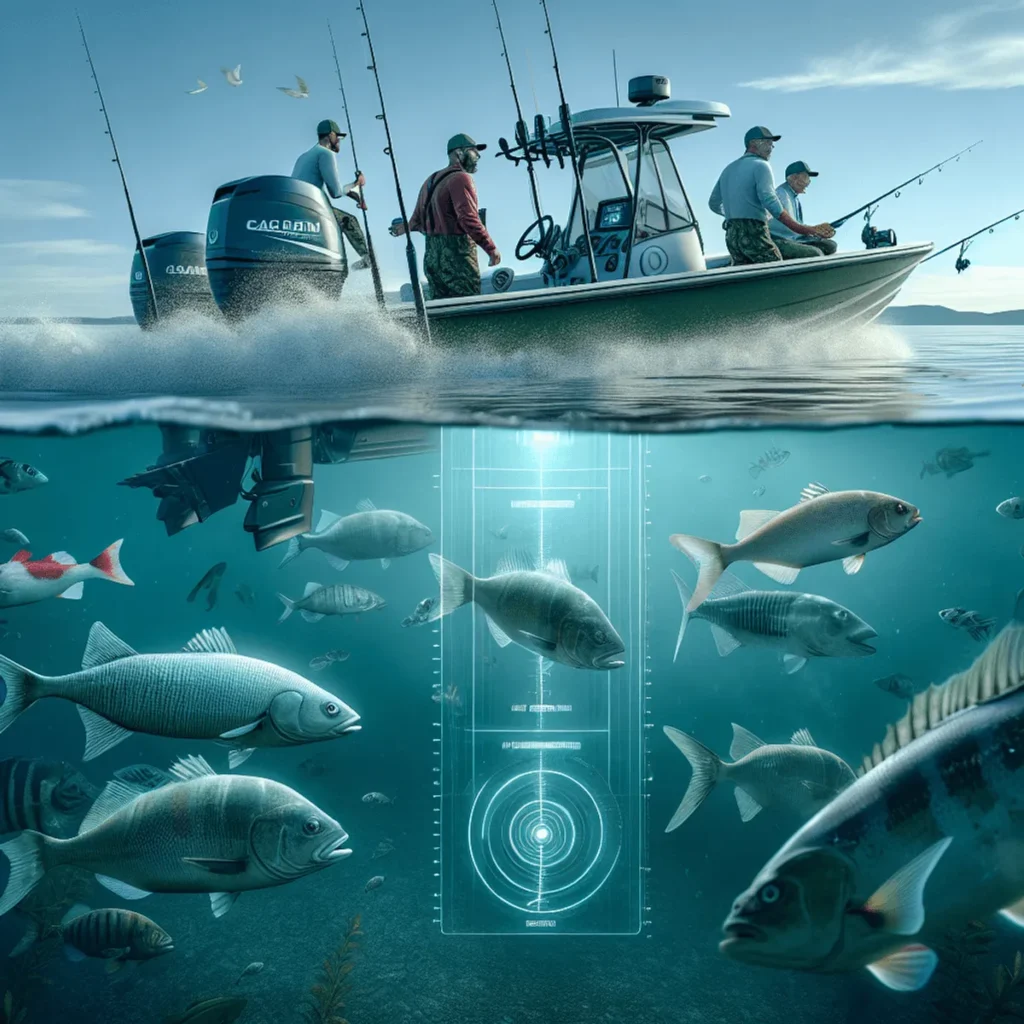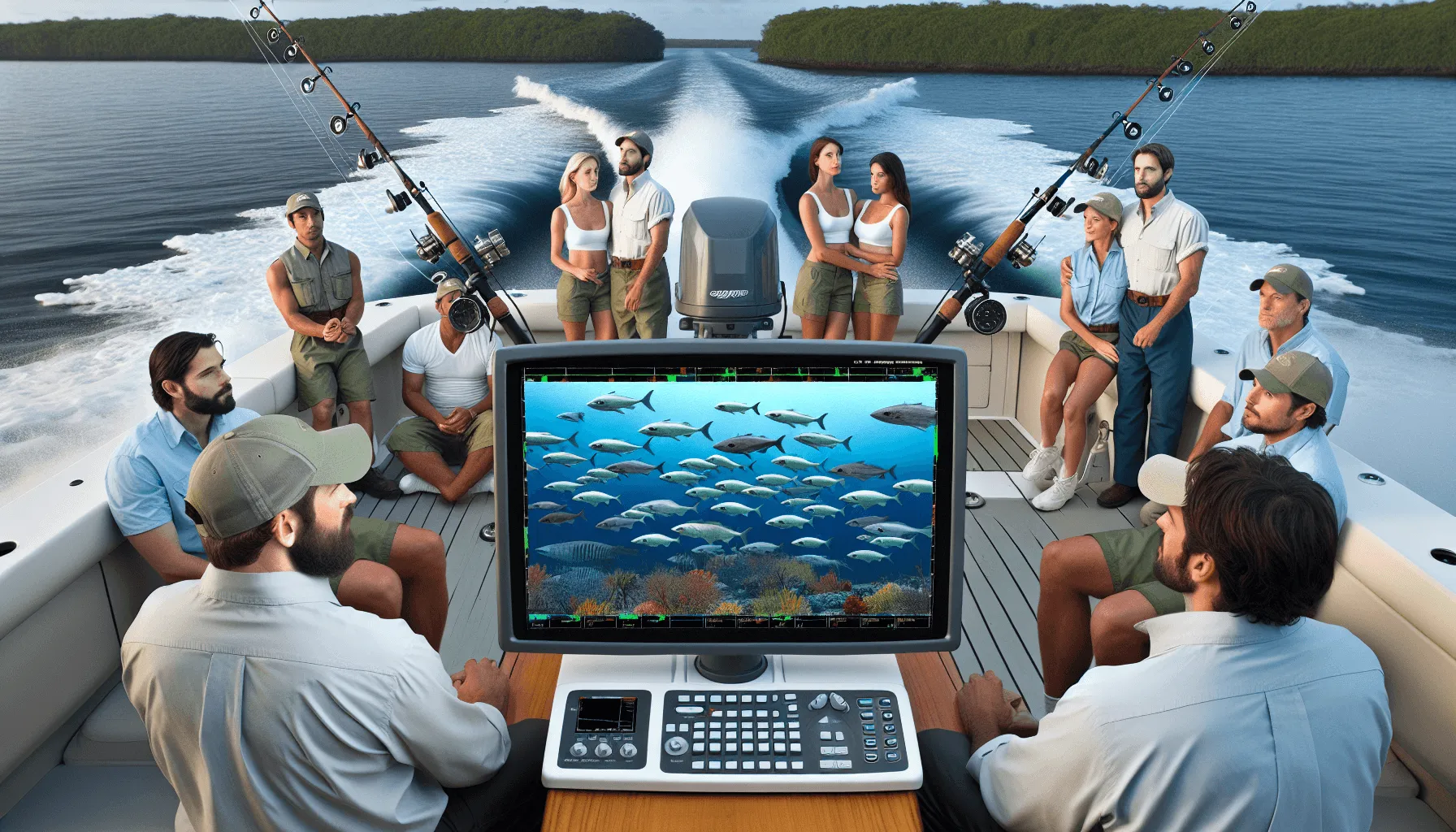Garmin LiveScope is a major breakthrough in fishing technology. Using forward-facing sonar, it offers real-time imaging that lets anglers view underwater environments and fish behavior with unparalleled clarity. This feature has transformed angling practices by simplifying the process of finding and catching fish.
However, there are growing concerns about using such advanced fishing technologies. Critics argue that tools like LiveScope can undermine traditional fishing methods and pose risks to fish populations by increasing catch rates beyond sustainable levels. These concerns have prompted regulatory actions in certain states.
In this article, we’ll provide a detailed list of states that have banned the use of LiveScope for fishing as of May 1, 2023. We’ll also delve into the reasons behind these regulatory decisions and their implications for both anglers and fish populations.
Understanding LiveScope Technology
Garmin LiveScope is a cutting-edge sonar system designed to enhance the fishing experience through advanced real-time imaging. This technology operates using forward-facing sonar, allowing anglers to visualize underwater environments like never before.
Key Features
- Real-Time Imaging: Unlike traditional sonar systems that provide historical data, LiveScope offers live feedback, enabling you to see fish and structures as they move.
- Forward-Facing Capabilities: This feature allows you to direct the sonar beam forward from your boat, giving a clear picture of what lies ahead in the water column.
- High-Resolution Display: The system delivers detailed images, making it easier to distinguish between different types of fish and underwater structures.
Advantages of Forward-Facing Sonar
Using forward-facing sonar like Garmin LiveScope brings several benefits to the angling community:
- Improved Target Detection: Traditional sonar often struggles with detecting fish near structures or in dense cover. LiveScope’s real-time imaging makes it easier to locate these hidden targets.
- Increased Catch Rates: By providing precise information on fish location and behavior, anglers can adjust their techniques on the fly, leading to improved success rates.
- Enhanced Understanding of Fish Behavior: The ability to observe how fish react to lures and bait in real time helps refine angling strategies, contributing to a more effective fishing approach.
Revolutionizing Angling Practices
The introduction of real-time imaging has transformed traditional angling. Anglers now have the capability to:
- Monitor Fish Movements: Watching fish behavior live allows for immediate adjustments in tactics, making fishing more dynamic and interactive.
- Identify Structures and Habitats: Real-time visuals help pinpoint specific areas where fish are likely to congregate, such as drop-offs, weed beds, and submerged structures.
- Make Informed Decisions: Access to live data empowers anglers with better decision-making tools, ensuring each fishing trip is productive.
Garmin LiveScope exemplifies the cutting-edge advancements in sonar technologies that are reshaping the landscape of recreational fishing.
The Controversy Surrounding LiveScope

The introduction of LiveScope technology has sparked a heated debate in the fishing community. Supporters highlight its ability to transform the fishing experience, offering real-time imaging and forward-facing sonar that enhance target detection and increase catch rates. However, critics argue that this technological advancement raises significant concerns.
Arguments For LiveScope Technology
- Enhanced Fishing Efficiency: By providing real-time visuals of underwater environments, LiveScope allows anglers to locate and target fish more effectively.
- Improved Learning Curve: Novice anglers can quickly understand fish behavior and habitat preferences, potentially leveling the playing field.
- Economic Benefits: The increased success rates can boost local economies reliant on recreational fishing tourism.
Arguments Against LiveScope Technology
- Fairness and Skill Level: Traditionalists contend that reliance on advanced technology diminishes the skill required in angling, making it less about expertise and more about equipment.
- Ecological Impact: There are worries that increased efficiency in catching fish could lead to overfishing, impacting sustainable fish stocks.
- Traditional Methods: Some believe that advanced technologies like LiveScope undermine age-old fishing practices, stripping away the essence of traditional angling.
Environmental Concerns
Critics emphasize that the rapid adoption of high-tech fishing tools like LiveScope may outpace regulatory frameworks designed to protect wildlife populations. The fear is that such technologies could disrupt fish behavior patterns and lead to unsustainable fishing practices.
Fisheries managers argue for a balanced approach, suggesting that while innovation is crucial, it should not come at the expense of ecological integrity. These opposing views underline the complexity of integrating new technologies into an industry deeply rooted in tradition and sustainability.
The ongoing debate encapsulates a broader discussion about balancing technological advancements with environmental stewardship in contemporary angling practices. Furthermore, the need for sustainable practices in fisheries management becomes increasingly critical as we navigate these technological advancements.
States That Have Banned LiveScope for Fishing
1. Oregon
Oregon has taken a definitive stance on the use of LiveScope technology in its waters. As of May 1, 2023, regulations have been implemented to restrict the use of this advanced sonar system. This decision was made after extensive discussions and consultations among fisheries managers, wildlife resource officers, and other relevant stakeholders.
Specific Regulations in Oregon:
- Prohibition in Certain Waters: The use of Garmin LiveScope is explicitly banned in several key fishing areas including major lakes, reservoirs, and specific river sections known for high fish traffic.
- Permits and Compliance: Anglers are required to obtain special permits if they intend to use any type of forward-facing sonar technology outside the restricted zones. Regular checks are conducted to ensure compliance with these regulations.
- Penalties for Non-Compliance: Violators of these rules face substantial fines, suspension of fishing licenses, and confiscation of equipment.
Insights from Fisheries Managers:
Fisheries managers in Oregon have expressed clear concerns about the impact of LiveScope on local fish populations and the fairness of angling practices. According to a recent statement by the Oregon Department of Fish and Wildlife (ODFW), the primary reasons for this ban include:
- Sustainability: There is a significant concern that advanced sonar technology like LiveScope could lead to overfishing by making it too easy to locate and catch large quantities of fish. This potentially threatens the sustainability of fish stocks.
- Fair Play: Traditional anglers argue that the use of such technology diminishes the skill required for fishing, creating an uneven playing field. By banning LiveScope, Oregon aims to preserve traditional angling methods that rely more on fisherman expertise than on technological aids.
- Ecological Balance: Real-time imaging allows anglers to target specific species with high precision. This can disrupt natural ecosystems by disproportionately affecting certain fish populations.
For instance, fisheries managers noted a noticeable decline in certain gamefish populations in areas where LiveScope usage was prevalent before the ban. These observations have propelled efforts to regulate this technology strictly.
The ODFW continues to monitor the effects of this ban closely and remains open to revisiting regulations based on ongoing research and feedback from both scientific communities and local anglers. In line with California’s approach towards sustainable fishing practices as outlined in their comprehensive Coastal Act, Oregon’s ban on LiveScope is a step towards preserving its aquatic resources while ensuring fair play in fishing practices.
2. Washington
Implications of the Ban on LiveScope
Washington’s decision to ban LiveScope technology directly impacts the angling community. The Department of Natural Resources (DNR) has emphasized that this measure aims to preserve fish populations by preventing overfishing facilitated by advanced sonar technologies.
Perspectives from Anglers and DNR Representatives
Anglers’ Viewpoints:
- Some anglers argue that using LiveScope levels the playing field, making it easier for less experienced fishermen to achieve success.
- Others believe it undermines traditional skills and sportsmanship, offering an unfair advantage.
DNR Representatives’ Insights:
- DNR officials stress that the ban is a proactive step towards sustainable fishing, ensuring fish populations remain robust for future generations.
- The department highlights that regulatory decisions are based on extensive research and input from fisheries managers, emphasizing the importance of such measures in maintaining ecological balance as detailed in this study on sustainable practices.
This balanced approach in Washington reflects a growing trend among states banning LiveScope, prioritizing ecological integrity while considering recreational interests.
3. California
California’s Position on LiveScope Regulation
California has taken a proactive stance in regulating LiveScope technology for recreational fishing. The state has implemented specific restrictions to address concerns about the fairness and sustainability of using advanced sonar systems. The California Department of Fish and Wildlife (CDFW) has highlighted the need to balance technological advancements with ecological integrity.
Potential Impacts on Local Gamefish Populations
The widespread adoption of LiveScope technology could significantly impact local gamefish populations. Real-time imaging allows anglers to target fish with unprecedented accuracy, potentially leading to overfishing and disrupting natural behaviors. For instance, studies have shown that such technology could contribute to the decline of certain species, similar to the situation faced by the Atlantic bluefin tuna. Fisheries managers in California emphasize the importance of maintaining healthy fish stocks and ensuring that fishing practices do not compromise future generations’ enjoyment of the sport.
Key Concerns:
- Overfishing due to increased catch rates
- Disruption of natural fish behaviors
- Need for balanced technological use
These considerations have led California to join other states in banning LiveScope technology, aiming to preserve its rich aquatic ecosystems. This decision is part of a broader effort to ensure sustainable fishing practices, which is crucial given the state’s diverse marine life and the ecological significance of its fisheries.
4. Texas
Texas has taken a firm stance on the regulation of LiveScope technology in recreational fishing. The state’s Department of Fish and Wildlife has implemented specific restrictions, aiming to preserve the integrity of traditional angling methods and protect local gamefish populations.
Key Points:
- Regulations: Texas mandates that anglers using LiveScope technology adhere to stringent guidelines to minimize its impact on fish stocks.
- Gamefish Populations: Fisheries managers have raised concerns about the potential overexploitation of gamefish species if real-time imaging becomes widespread. They argue that the improved target detection provided by LiveScope could lead to unsustainable catch rates, ultimately harming local ecosystems.
By imposing these regulations, Texas aims to balance technological advancements with ecological preservation, ensuring that future generations can continue to enjoy recreational fishing.
5. Florida
Florida is taking a careful approach to LiveScope technology for recreational fishing. The state has put in place strict regulations to manage its use, reflecting worries about how it might affect local gamefish populations. The Florida Fish and Wildlife Conservation Commission (FWC) stresses the need for sustainable fishing practices and is cautious about how forward-facing sonar could influence fish behavior and their environment.
If LiveScope technology were widely used in Florida, it could have several effects:
- Higher Catch Rates: Being able to find fish more easily might lead to overfishing, putting pressure on popular gamefish species.
- Changes in Behavior: Constant real-time imaging could interfere with natural fish behaviors, making it harder for them to feed and reproduce.
- Ecosystem Imbalance: Relying too much on advanced technologies might upset the balance within aquatic ecosystems, potentially harming non-target species.
These factors highlight the state’s dedication to preserving its rich fishing tradition while balancing modern technological progress.
How Fisheries Managers and State Agencies Enforce These Bans

Fisheries managers play a crucial role in making regulatory decisions. They are at the forefront of assessing the impacts of technologies like LiveScope on fish populations and angling practices. Their expertise guides the formulation of regulations aimed at balancing technological advancements with sustainable fishing practices. By evaluating data on fish behavior, population dynamics, and catch rates, fisheries managers can make informed decisions about the necessity and scope of bans on forward-facing sonar technologies.
State agencies such as Departments of Fish and Wildlife or Natural Resources bear significant responsibilities in ensuring compliance with these bans. These agencies are tasked with:
- Monitoring: Conducting regular patrols and surveillance to ensure that anglers adhere to the regulations.
- Education: Providing resources and information to the public about the reasons behind the ban and how it benefits fish populations and ecosystems.
- Enforcement: Implementing penalties for violations, which may include fines or revocation of fishing licenses.
The collaboration between fisheries managers and state agencies ensures that regulations like those against LiveScope technology are effectively communicated, understood, and enforced. This collaborative approach is essential for maintaining healthy fish populations and promoting fair play in recreational fishing.
Anglers and Fishing Communities React to Livescope Restrictions
Anglers’ opinions on Livescope bans reveal a spectrum of perspectives. Many avid anglers appreciate the technological edge that LiveScope provides, arguing that it enhances their fishing experience and increases their success rates. For these enthusiasts, the restrictions feel like a step backward, limiting their ability to utilize modern tools.
On the other hand, a significant number of traditionalists and conservation-minded anglers support the bans. They believe that LiveScope undermines the skill and patience historically associated with angling. The concern is that reliance on such advanced technology could diminish the sport’s challenge, making it too easy to catch fish and potentially leading to overfishing.
Local communities dependent on recreational angling tourism are also divided:
- Proponents of LiveScope: These individuals argue that allowing advanced technologies can attract more tourists, boosting local economies.
- Opponents of LiveScope: Critics worry that unsustainable fishing practices enabled by real-time imaging might harm fish populations in the long run, eventually reducing tourism as fish stocks dwindle.
Voices from both sides highlight the complexity of balancing technological advancements with sustainable practices. The ongoing debate underscores the need for thoughtful regulation that considers both ecological integrity and the evolving nature of recreational fishing.
Implications for Future Fishing Regulations Beyond Just LiveScope Technology
Long-term sustainability concerns for recreational fisheries management strategies stem from the need to address not just LiveScope but all advanced fishing technologies. By focusing solely on LiveScope, there is a risk of neglecting other equally impactful tools such as traditional sonar systems and imaging tools.
Potential Long-Term Effects
- Strict Regulation of One Technology: Targeting LiveScope alone may lead to a fragmented approach in managing fisheries. Instead, a comprehensive strategy addressing all technological advancements can ensure fair play and sustainability.
- Innovation vs. Ecological Integrity: The balance between embracing innovation and preserving ecosystems remains a challenge. Advanced technologies offer significant advantages but can disrupt fish populations if not regulated properly.
Ongoing Debates
Debates continue around:
- Fairness in Angling Practices: Anglers and conservationists are divided on how to incorporate new technologies without compromising the sport’s essence and ecological balance.
- Holistic Management Approaches: There is increasing advocacy for regulations that encompass various forms of technology, ensuring that no single advancement disproportionately affects fish populations or traditional fishing methods.
By considering these factors, future regulations can better align with the goal of maintaining healthy fish stocks while allowing the sport to evolve with technological advancements.
FAQs (Frequently Asked Questions)
What is Garmin LiveScope and how does it work?
Garmin LiveScope is a forward-facing sonar technology that provides real-time imaging of underwater environments. It allows anglers to see fish behavior and structure in real time, enhancing target detection and increasing catch rates.
Which states have banned the use of LiveScope for fishing as of May 1, 2023?
As of May 1, 2023, states that have implemented bans on the use of LiveScope for fishing include Oregon, Washington, California, Texas, and Florida. Each state has specific regulations regarding its use.
What are the main concerns regarding the use of LiveScope technology in fishing?
Concerns surrounding LiveScope technology include fairness in fishing practices, potential harm to fish populations, and the impact on traditional fishing methods. Critics argue that advanced technologies may undermine the skill required in angling and threaten sustainable fish stocks.
How do fisheries managers influence regulations related to LiveScope?
Fisheries managers play a crucial role in formulating regulations against technologies like LiveScope by providing scientific insights and recommendations based on fish population health and sustainability. State agencies rely on their expertise to ensure compliance with these bans.
What reactions have anglers had towards the restrictions on LiveScope?
Reactions among anglers regarding restrictions on LiveScope usage are mixed. Some support the bans for sustainability reasons, while others feel that such regulations limit their fishing experience. The perspectives vary widely within local communities dependent on recreational angling tourism.
What are the potential long-term implications of regulating technologies like LiveScope?
Regulating specific technologies like LiveScope may lead to discussions about broader management strategies for all forms of advanced fishing tools. This could affect long-term sustainability practices in recreational fisheries management and raise questions about balancing innovation with ecological integrity.




